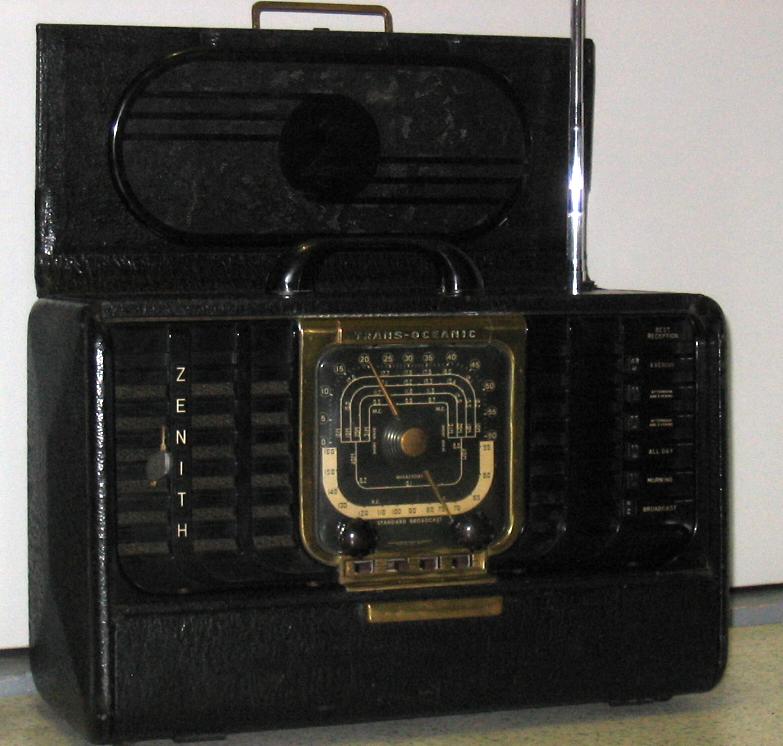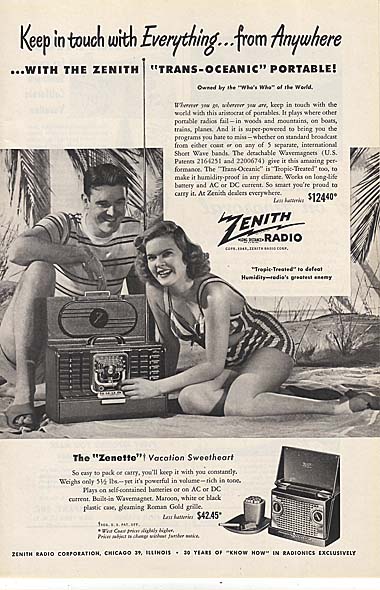
 The 8G005 was the second line of Zenith TransOceanics, produced between 1947 and 1950. It is the model with highest tube count (8) because it has both a push-pull output, and a tube rectifier for mains operation.
The 8G005 was the second line of Zenith TransOceanics, produced between 1947 and 1950. It is the model with highest tube count (8) because it has both a push-pull output, and a tube rectifier for mains operation.

233
Item nr.

Member of a legendary series of American ShortWave radios.
| Production | USA, 1947.
Price was 120 USD. |
|---|---|
| Bands | MW (535-1620 kHz), SW1 (6.0-6.27 MHz), SW2 (9.4-9.9 MHz), SW3 (11.6-12.1 MHz), SW4 (15.0-15.6 MHz), SW5 (17.5-18.3 MHz); IF is 455kHz. |
| Tubes | 1LN5 (RF), 1LA6 (Mixer/osc.), 1LN5 (IF amp), 1LD5 (det. and AF amp), 1LE3 (Phase inverter), 2x 1LB4 (push-pull output), 117Z3 (line rectifier). |
| Cabinet | Wood. Size 43x27x19cm. Weight 7.9 kg (sans batt.). |
| Power | AC 117V or batteries (90V and 10.5V). |
| Documents | Schema, Sam's Photofacts. |
 The Trans-Oceanic series of portable shortwave receivers is legendary because these radios were used a lot by American soldiers in various wars in the 1940-1960 period. The construction was very rugged (this TO weighs 8 kilos, which is for almost 5 kg due to its sturdy wood case) to survive in whatever condition, and the radio was equipped with various antennas so as to prove of use in many conditions. For example, the MW loop antenna (called Wave Magnet) could be taken out of the case and connected via an extension cable, to put it outside a hiding cave or vehicle.
The Trans-Oceanic series of portable shortwave receivers is legendary because these radios were used a lot by American soldiers in various wars in the 1940-1960 period. The construction was very rugged (this TO weighs 8 kilos, which is for almost 5 kg due to its sturdy wood case) to survive in whatever condition, and the radio was equipped with various antennas so as to prove of use in many conditions. For example, the MW loop antenna (called Wave Magnet) could be taken out of the case and connected via an extension cable, to put it outside a hiding cave or vehicle. 
 To illustrate the fame of the TO series, I give you some photo's. On the right an American officer, testing the camel radio concept in Pakistan, 1954. Please realise that the radio weighs 8 kilos without batteries, so this is actually an arm test! On the left some American soldiers overhearing the results of the 1952 presidential elections.
To illustrate the fame of the TO series, I give you some photo's. On the right an American officer, testing the camel radio concept in Pakistan, 1954. Please realise that the radio weighs 8 kilos without batteries, so this is actually an arm test! On the left some American soldiers overhearing the results of the 1952 presidential elections. 
 The 8G005 was the second line of Zenith TransOceanics, produced between 1947 and 1950. It is the model with highest tube count (8) because it has both a push-pull output, and a tube rectifier for mains operation.
The 8G005 was the second line of Zenith TransOceanics, produced between 1947 and 1950. It is the model with highest tube count (8) because it has both a push-pull output, and a tube rectifier for mains operation.
| Obtained | 12/2003 from NVHR swap meet; sn=B200882. |
|---|---|
| Condition | 7; I played it on battery and mains, but sensitivity is too low. |
| Disposed | Sold 9/2017. |
| Sound sample | PLAY SOUND  The singer and the radio are equally old, both from 1947. When she peaked, in the seventies, the radio was in decline. Emmylou Harris interpreted C'est la vie, you never can tell in 1977. She looked nice all the time, but I think her current hair style is superb. In 2006, the singer is ready for retirement, but the radio was restored to working order and may continue to work for decades. C'est la vie ... The singer and the radio are equally old, both from 1947. When she peaked, in the seventies, the radio was in decline. Emmylou Harris interpreted C'est la vie, you never can tell in 1977. She looked nice all the time, but I think her current hair style is superb. In 2006, the singer is ready for retirement, but the radio was restored to working order and may continue to work for decades. C'est la vie ... |
 During its six decade lifetime, the radio was once imported officially into the Netherlands, as witnessed by a metal Costumers' decal.
During its six decade lifetime, the radio was once imported officially into the Netherlands, as witnessed by a metal Costumers' decal.  The radio came without batteries, which is understandible. On the inside there is a little sticker (photo) with the tube layout and a long list of patent numbers.
The radio came without batteries, which is understandible. On the inside there is a little sticker (photo) with the tube layout and a long list of patent numbers.  Now let me take you through a tour around my set. It has three lids, the main one being the one that opens to operate the radio. On its inside one is supposed to find the WaveMagnet, which is a loop antenna. It is detachable, but my set is complete with the WaveMagnet. An additional accessoire exists, an extension cable that allows to stick the WaveMagnet out of a window or bomb shelter, but I do not have that cable. On the right top. one finds the WaveRod, an extendible rod antenna, which is still there as well on my radio, including its original bakelite top.
Now let me take you through a tour around my set. It has three lids, the main one being the one that opens to operate the radio. On its inside one is supposed to find the WaveMagnet, which is a loop antenna. It is detachable, but my set is complete with the WaveMagnet. An additional accessoire exists, an extension cable that allows to stick the WaveMagnet out of a window or bomb shelter, but I do not have that cable. On the right top. one finds the WaveRod, an extendible rod antenna, which is still there as well on my radio, including its original bakelite top. 
 Below the main lid there is a smaller lid that hides the user instruction manual and a log book. The log mentions Havana, Dakar, Congo, Voice of America, Honolulu, Tanger, Radio Nederland (perhaps preparing for the emigration?), testifying that the owner was a true DX-er. The logs are not dated, and I have not made any attempts to find out when or where the transmissions were received. The right picture shows the back lid. There you can see the chassis with tubes, the batteries, and the additional ShortWave antenna, the SW WaveMagnet. To use batteries, the power plug must be fit into slits on the chassis, so, paradoxically, you cannot play the radio on batteries if you don't have the power plug!
Below the main lid there is a smaller lid that hides the user instruction manual and a log book. The log mentions Havana, Dakar, Congo, Voice of America, Honolulu, Tanger, Radio Nederland (perhaps preparing for the emigration?), testifying that the owner was a true DX-er. The logs are not dated, and I have not made any attempts to find out when or where the transmissions were received. The right picture shows the back lid. There you can see the chassis with tubes, the batteries, and the additional ShortWave antenna, the SW WaveMagnet. To use batteries, the power plug must be fit into slits on the chassis, so, paradoxically, you cannot play the radio on batteries if you don't have the power plug!
When I bought this radio, it missed quite a few parts, and when I started working on it, I found out that a few others needed replacement. So I should acknowledge a few people here who helped me to get the radio to completeness. David helped me to find the Short Wave Magnet through eBay, where I bought it from Phil. Hans could supply me with the Medium Wave Magnet and gave me some brass work for the lock. John sent me a 1LC6 tube for free. Esther sent me US power plugs all the way from over the Atlantic. Wim de Rotte sent me two 1LN5 tubes.
After tube replacement, the radio works well (as you can hear). It plays on either 110V mains (AC or DC) and on batteries. I use one 9V rechargeable for the filaments (draw is 50mA), and six of these combined to 54V for the plate (draw is 5 to 7mA).
I estimate the radio, now fairly complete and in working order, to value about 100 euros.